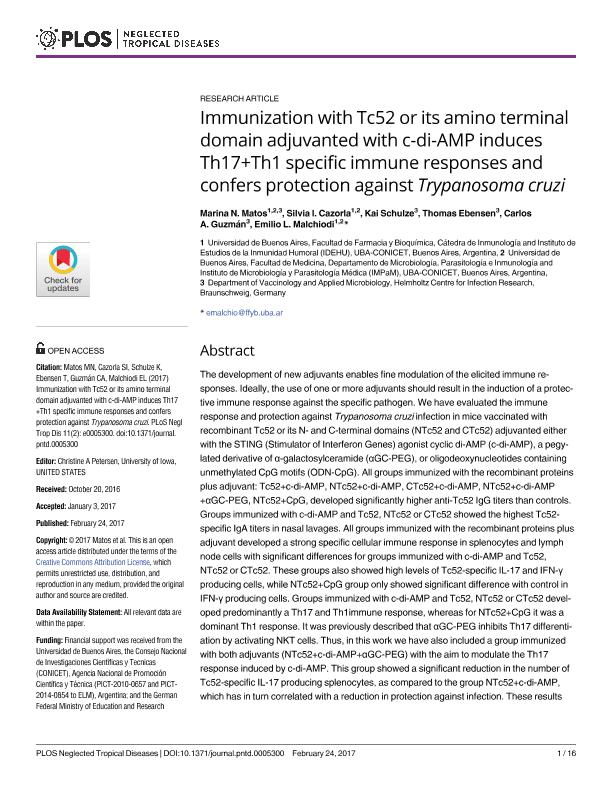Artículo
Immunization with Tc52 or its amino terminal domain adjuvanted with c-di-AMP induces Th17+Th1 specific immune responses and confers protection against Trypanosoma cruzi
Matos, Marina Nadia ; Cazorla, Silvia Ines
; Cazorla, Silvia Ines ; Schulze, Kai; Ebensen, Thomas; Guzmán, Carlos A.; Malchiodi, Emilio Luis
; Schulze, Kai; Ebensen, Thomas; Guzmán, Carlos A.; Malchiodi, Emilio Luis
 ; Cazorla, Silvia Ines
; Cazorla, Silvia Ines ; Schulze, Kai; Ebensen, Thomas; Guzmán, Carlos A.; Malchiodi, Emilio Luis
; Schulze, Kai; Ebensen, Thomas; Guzmán, Carlos A.; Malchiodi, Emilio Luis
Fecha de publicación:
02/2017
Editorial:
Public Library of Science
Revista:
PLoS Neglected Tropical Diseases
ISSN:
1935-2735
Idioma:
Inglés
Tipo de recurso:
Artículo publicado
Clasificación temática:
Resumen
The development of new adjuvants enables fine modulation of the elicited immune responses. Ideally, the use of one or more adjuvants should result in the induction of a protective immune response against the specific pathogen. We have evaluated the immune response and protection against Trypanosoma cruzi infection in mice vaccinated with recombinant Tc52 or its N- and C-terminal domains (NTc52 and CTc52) adjuvanted either with the STING (Stimulator of Interferon Genes) agonist cyclic di-AMP (c-di-AMP), a pegylated derivative of α-galactosylceramide (αGC-PEG), or oligodeoxynucleotides containing unmethylated CpG motifs (ODN-CpG). All groups immunized with the recombinant proteins plus adjuvant: Tc52+c-di-AMP, NTc52+c-di-AMP, CTc52+c-di-AMP, NTc52+c-di-AMP+αGC-PEG, NTc52+CpG, developed significantly higher anti-Tc52 IgG titers than controls. Groups immunized with c-di-AMP and Tc52, NTc52 or CTc52 showed the highest Tc52-specific IgA titers in nasal lavages. All groups immunized with the recombinant proteins plus adjuvant developed a strong specific cellular immune response in splenocytes and lymph node cells with significant differences for groups immunized with c-di-AMP and Tc52, NTc52 or CTc52. These groups also showed high levels of Tc52-specific IL-17 and IFN-γ producing cells, while NTc52+CpG group only showed significant difference with control in IFN-γ producing cells. Groups immunized with c-di-AMP and Tc52, NTc52 or CTc52 developed predominantly a Th17 and Th1immune response, whereas for NTc52+CpG it was a dominant Th1 response. It was previously described that αGC-PEG inhibits Th17 differentiation by activating NKT cells. Thus, in this work we have also included a group immunized with both adjuvants (NTc52+c-di-AMP+αGC-PEG) with the aim to modulate the Th17 response induced by c-di-AMP. This group showed a significant reduction in the number of Tc52-specific IL-17 producing splenocytes, as compared to the group NTc52+c-di-AMP, which has in turn correlated with a reduction in protection against infection. These results suggest that the Th17 immune response developed after immunizing with NTc52+c-di-AMP could have a protective role against T. cruzi infection. Groups NTc52+c-di-AMP, Tc52+c-di-AMP and NTc52PB, were the ones that showed better protection against infection with lower parasitemia and weight loss, and higher survival.
Palabras clave:
Enfermedad de Chagas
,
Trypanosoma Cruzi
,
Vacuna
,
Tc52
Archivos asociados
Licencia
Identificadores
Colecciones
Articulos(CERELA)
Articulos de CENTRO DE REFERENCIA PARA LACTOBACILOS (I)
Articulos de CENTRO DE REFERENCIA PARA LACTOBACILOS (I)
Citación
Matos, Marina Nadia; Cazorla, Silvia Ines; Schulze, Kai; Ebensen, Thomas; Guzmán, Carlos A.; et al.; Immunization with Tc52 or its amino terminal domain adjuvanted with c-di-AMP induces Th17+Th1 specific immune responses and confers protection against Trypanosoma cruzi; Public Library of Science; PLoS Neglected Tropical Diseases; 11; 2; 2-2017; 1-16
Compartir
Altmétricas



